When you think of an office chair, most people think of the standard swivel chair and rightly so as this is the most common chair that we see being used in offices and home workstations.
As per the Safety, Health and Welfare at Work (General Application) Regulations 2007, Chapter 5 of Part 2: Display Screen Equipment, there is a minimum standard for chairs to be used at a DSE workstation. This includes a 5 spoke base on castors, height adjustable seat and adjustable backrest. These are considered the minimum requirements to allow DSE seating to be supportive and comfortable for most users.
During virtual home DSE assessments, I am increasingly asked, by users looking to purchase their own seating, about the benefits of an active seating option over the traditional office chair.
In this blog post I will highlight some of the active seating options available for DSE users, as well as the pros and cons of active seating as a workstation option.
What is Active Seating?
I would define active seating, or dynamic seating, as any seating option that encourages small movements in the seated position, while requiring engagement of the core muscles to maintain an upright position.
Active seating should encourage frequent small changes of posture without impacting concentration or focus.
Some traditional office chairs consider themselves as active seating due to flexibility in the seat and backrest position. However, I would not class these as active seating as they do not require engagement of the core to maintain an upright position.
Types of Active Seating
Active seating comes in a wide range of shapes and sizes.
Swiss / Stability / Exercise Ball
One of the most common active seating options that I am asked about is the Swiss or Exercise ball.
This is a large inflated ball that is available as the traditional ball or integrated into a frame.
There are also variations available that mimic an exercise ball but placed on top of a height adjustable gas stem.
Inflatable seat cushions are a space saving alternative for use with standard chairs.
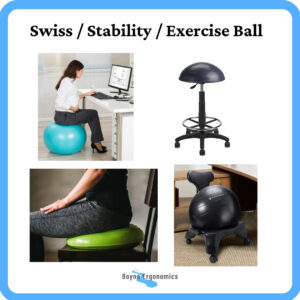
Kneeling Chair
The kneeling chair is a seating option that divides the weight between the shins, knees and the buttocks.
They are available in a fixed, rocking or adjustable version.
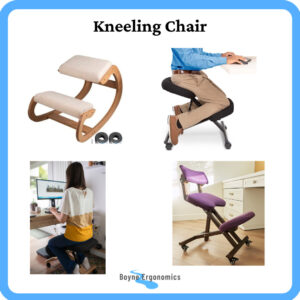
Saddle Stool
The saddle stool is often seen in dentistry, medical settings and laboratory settings but has become popular in office settings in recent years.
They are usually height adjustable and on castors for ease of movement.
Due to their design the seated position mimics the horse riding position, legs apart, knees below hips and pelvis tilted forward.
They are available with and without a backrest.
The seat can be one solid surface or split in two and some models have a tilt adjustable seat.
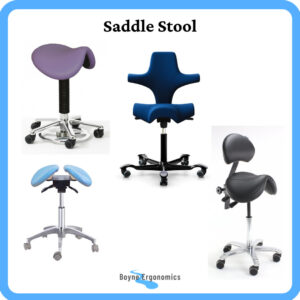
Balance Stool
Balance stools are stools with a rounded base, a comfortable seat and height adjustment. They come in a range of designs but all require constant muscular engagement to remain seated and upright.
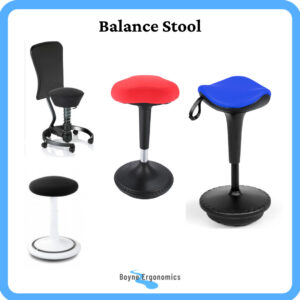
Leaning Stool
Leaning stools are stools designed for use at standing workstations. The user can pivot and flex, easily adjusting between seated and standing.
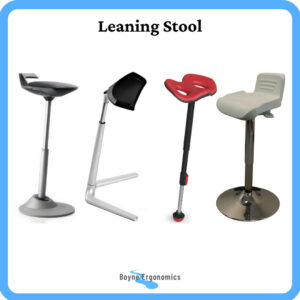
What are the Pros of Active / Dynamic Seating?
When an appropriate active seating option is used correctly, it can offer the following benefits.
Increased Pelvic Movement
Frequent small movements of the pelvis improves mobility of the upper and lower body and encourages blood flow to the intervertebral discs.
Increased Core Strength
Increased activation of the core stabiliser muscles can help develop and strengthen them and the muscles around them over time.
Improved Posture
The right active seating option will encourage the natural curvature of the spine, encouraging an upright posture. This will have a knock on effect on the functioning of the respiratory system and digestive system.
Improved Blood Flow
The regular small movements encourage increased blood flow, improving oxygen circulation and waste removal from the muscles.
Reduced Muscle Tension
The regular small movements and increased blood flow reduce static loading and tension in the muscles.
What are the Cons of Active / Dynamic Seating?
Increased Fatigue
The constant mobility and muscle activation can cause tiredness and fatigue, especially in the back and shoulders.
Adverse Postures
The fatigue in the muscles and lack of back support can encourage a slumped posture with rounded shoulders with prolonged use.
Incompatibility with Other Office Furniture
Depending on stature and the height of the work surface, there is a risk of increased tension in the upper body or contact stress in the wrists or forearms due to incorrect seated height.
Discomfort in Sit Bones / Knees
Due to the pressure points when seated in a saddle stool or a kneeling chair, users can experience discomfort in the sit bones, the knees or the shins.
Active Seating – Final Thoughts
On paper, active seating offers a great alternative to the standard office chair for users with a dedicated workstation.
If you are thinking of changing to an active seating option, I advise phasing it in over time, starting with 20 minutes before taking a microbreak from the desk and going back to the supportive seating. This can be increased over time to build up muscular stamina.
Active seating is a great option to have to use with an adjustable sit stand workstation as the surface height can be adjusted to suit the seating and offers the option to stand at the workstation to reduce muscular load associated with sitting, active and passive.
However, in practice, based on assessments with average DSE users, most users do not have the appropriate baseline core strength to maintain an upright posture for the amount of time they regularly spend seated.
I also recommend working to increase overall core strength via exercise and Pilates to allow you to make better use of your active seating.


